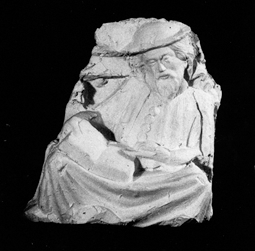'Aristotle', Detail from the 'Philosopher's Capital'
Plaster Cast from the Doge's Palace, Venice, 1880s.
WorkThis cast comes from a fourteenth-century capital of the Ducal Palace, dedicated to the philosophers. Apart from Aristotle -- who is shown here -- the capital includes likenesses of Solomon, Priscian (grammarian), Cicero, Pythagorus, Euclid, Tubal Caon (musician), and Ptolemy.
Ruskin on the 'Philosopher's Capital'Ruskin referred to this capital in Letter 77 (May 1877) of Fors Clavigera:'By this day's post I send you photographs of two fourteenth-century capitals of the Ducal Palace here. The first is that representing the Virtues; the second, that representing the Sages whose power has been greatest over men. Largitas (Generosity) leads the Virtues; Solomon, the Sages; but Solomon's head has been broken off by recent republican movements in Venice; and his teaching superseded by that of the public press -- as "Indi-catore general" -- you see the inscription in beautiful modern bill type, pasted on the pillar.Above sits Priscian the Grammarian; and next to him, Aristotle the Logician: whom that in contemplating you may learn the right and calm use of reason, I have to-day given orders to pack, with extreme care, a cast of him, which has been the best ornament of my room here for some weeks; and when you have examined him well, you shall other casts of other sages.' (Works, 29, p. 116). Ruskin on the Doge's PalaceRuskin wrote in The Stones of Venice that 'The Ducal palace of Venice contains [...] three elements in exactly equal proportions -- the Roman, Lombard, and Arab. It is the central building of the world.' (Works, 9, p. 38). Collection of the Guild of St George, Museums Sheffield
Ruskin on SculptureThe reason for the Museum's emphasis on sculpture is given in the 'General Statement Explaining the Nature and Purposes of St George's Guild' (1882):'Sculpture is the foundation and school of painting; but painting, if first studied, prevents, or at least disturbs, the understanding of the qualities of Sculpture. Also, it is possible to convey a perfect idea of the highest quality of Sculpture by casts, and even, in the plurality of cases, to know more of it by a well-lighted cast than can be known in its real situation. But it is impossible to copy a noble painting with literal fidelity; and the carefullest studies from it by the best artists attempt no more than to reproduce some of its qualities reverently, and to indicate what farther charms are to be sought in the original.' (Works, 30, p. 56).Ruskin then states that 'The Sheffield Art Gallery will [...] be unencumbered by any life-size statues whatsoever, and in the niches and lighted recesses of its walls will show only such examples of the art of Sculpture as may best teach the ordinary workman the use of his chisel, and his wits, under such calls as are likely to occur for either in the course of his daily occupations.' (Works, 30, p. 56). |



















